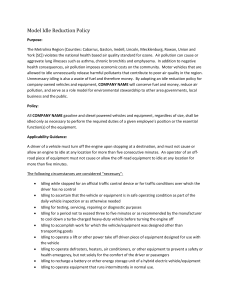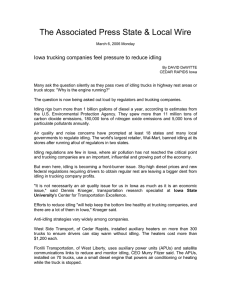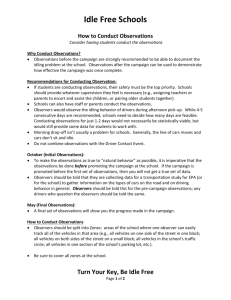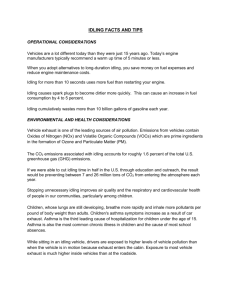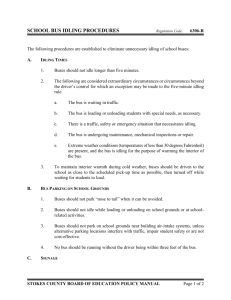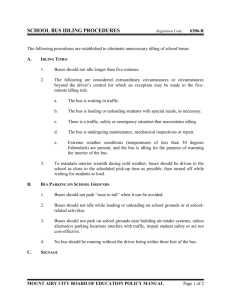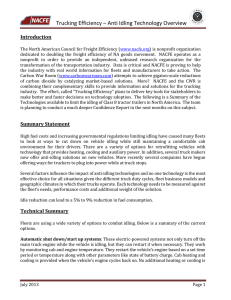Fort Dodge Messenger, IA 03/07/06 Idling rigs costing money
advertisement
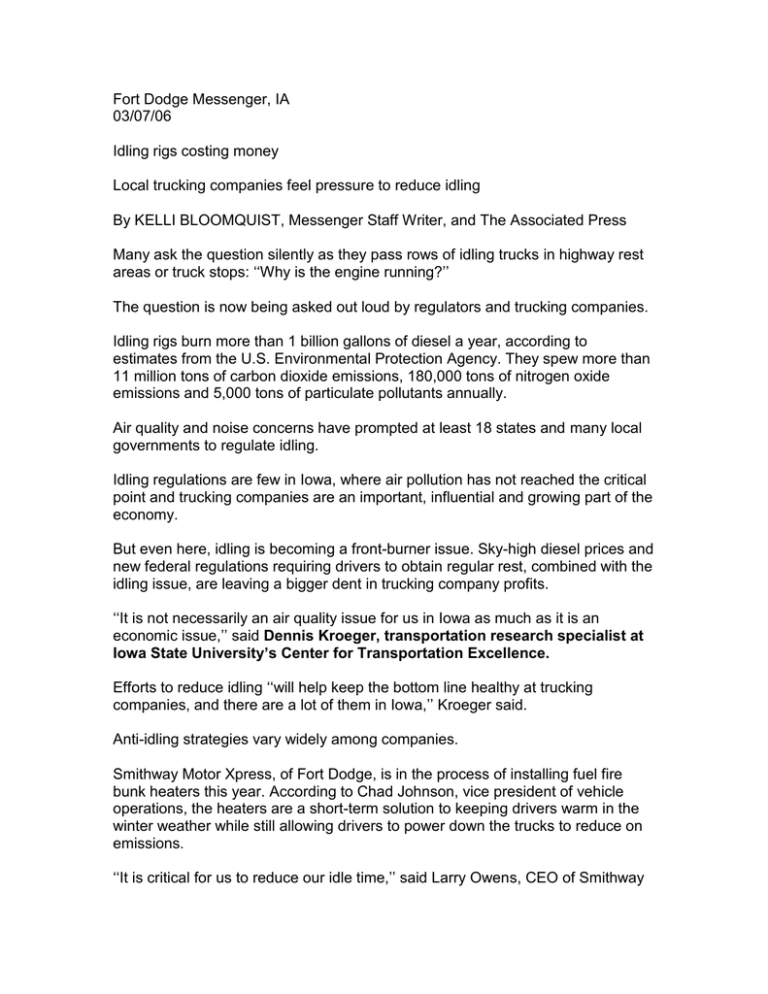
Fort Dodge Messenger, IA 03/07/06 Idling rigs costing money Local trucking companies feel pressure to reduce idling By KELLI BLOOMQUIST, Messenger Staff Writer, and The Associated Press Many ask the question silently as they pass rows of idling trucks in highway rest areas or truck stops: ‘‘Why is the engine running?’’ The question is now being asked out loud by regulators and trucking companies. Idling rigs burn more than 1 billion gallons of diesel a year, according to estimates from the U.S. Environmental Protection Agency. They spew more than 11 million tons of carbon dioxide emissions, 180,000 tons of nitrogen oxide emissions and 5,000 tons of particulate pollutants annually. Air quality and noise concerns have prompted at least 18 states and many local governments to regulate idling. Idling regulations are few in Iowa, where air pollution has not reached the critical point and trucking companies are an important, influential and growing part of the economy. But even here, idling is becoming a front-burner issue. Sky-high diesel prices and new federal regulations requiring drivers to obtain regular rest, combined with the idling issue, are leaving a bigger dent in trucking company profits. ‘‘It is not necessarily an air quality issue for us in Iowa as much as it is an economic issue,’’ said Dennis Kroeger, transportation research specialist at Iowa State University’s Center for Transportation Excellence. Efforts to reduce idling ‘‘will help keep the bottom line healthy at trucking companies, and there are a lot of them in Iowa,’’ Kroeger said. Anti-idling strategies vary widely among companies. Smithway Motor Xpress, of Fort Dodge, is in the process of installing fuel fire bunk heaters this year. According to Chad Johnson, vice president of vehicle operations, the heaters are a short-term solution to keeping drivers warm in the winter weather while still allowing drivers to power down the trucks to reduce on emissions. ‘‘It is critical for us to reduce our idle time,’’ said Larry Owens, CEO of Smithway Motor Xpress. ‘‘We are making sure that our drivers are comfortable but also working on reducing emissions and our overall idle time. The heaters should help quite a bit with this.’’ Decker Truck Line Inc., of Fort Dodge, is also keeping an eye on drivers’ idle time. ‘‘We are watching idle time very closely,’’ said Decker special projects manager Steve Larson. ‘‘We also have a bonus program in which drivers with the lowest idle time are paid a bonus. This is helping us to save on fuel and on emissions.’’ According to Larson, Decker is also installing fuel fire bunk heaters. ‘‘We are actively installing these heaters in our fleet,’’ said Larson. ‘‘I would say one-third of the fleet has the heaters and that number continues to increase daily.’’ For trucking companies that typically do not travel long distances over a period of days, such as Lakeville Motor Express, which has a terminal in Fort Dodge, idle time doesn’t play as significant of a role. ‘‘Our guys don’t go over the road,’’ said terminal manager Jim Wengryn. ‘‘They leave in the morning, make their delivery and are home at night. Idle time isn’t as big of an issue for us. But with the cost of fuel, we are very cognizant of idle time and actually plug in to keep warm while in the terminal instead of idling. “We have installed new electrical outlets throughout the building to make sure that we are not running our trucks constantly in the winter time. But for us, it is more a matter of training and awareness so that we can conserve as best we can.’’ Conservation is they key. Decker has reduced its idle time from 30 percent to 25 percent in the last year, Larson said. Smithway Motor Xpress is also working to reduce its total idle time down from 40 percent. Developing strategies to reduce idling isn’t easy, because turning off a rig’s engine can affect the driver’s comfort. Competition from good drivers is intense. Some truckers travel with dogs for company and keep engines idling so they don’t overheat during their rest breaks. Idling engines also keep the truck’s battery charged. Truckers use power inverters to run microwave ovens, televisions and portable computers off the truck’s electrical system during long weeks on the road. Some travel centers, such as Pilot Travel Centers, are proactively working with truckers. Pilot Travel Centers plans to offer 72 IdleAire truck parking stalls at the company’s Urbandale location. IdleAire systems provide cable TV, telephone, Internet service, electricity, heat and air conditioning via units that mount in a cab window. These systems have obvious attraction when they are available, according to ISU experts. They cost about $1.50 per hour to operate basic service versus the $3-per-hour cost of idling a truck. However, they don’t allow truckers to stop wherever they run out of driving hours, which many see as critical. ‘‘The holy grail would be to equip trucks with an APU powered by a (hydrogen) fuel cell which is a nonpolluting power source,’’ said Randy Boeckenstedt, a transportation research specialist at ISU. Trucking executives want APUs to prove their worth before they commit $8,000 each to equip trucks. ‘‘We have a number of trucks with APUs,’’ said Larson. ‘‘But there are weight, maintenance and cost issues involved with that.’’ While trucking firms throughout the country look at ways to reduce idle time, many report that it isn’t yet a serious problem, but that many states are beginning to institute legal parameters for truckers to follow. ‘‘I know in California by January of 2008 they are planning to outlaw idling all together,’’ said Johnson. ‘‘They are trying to restrict idle time to no more than five minutes. Typically, though laws like this are being instituted by bigger cities like Chicago, Minneapolis, etc. It isn’t a bad idea, and it is helping us to keep our costs down as well.’’
